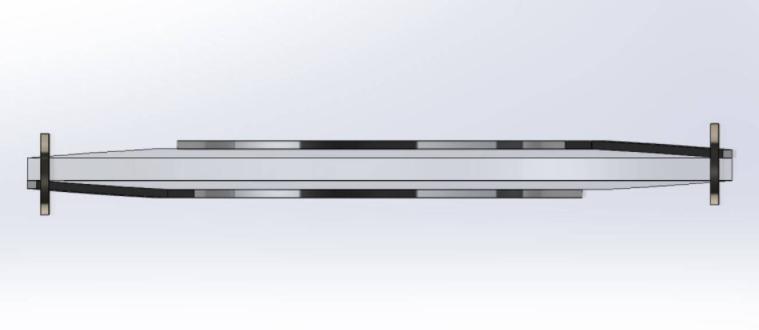福克斯石英晶体呈现过程
福克斯石英晶体呈现过程,美国FOX公司是一家有着超级丰富经验的元器件制造商,凭借着自身的聪明才智,开创大量高品质的晶振产品,随着市场不断波动与变化,为了更好应对市场风险,福克斯公司不断打磨自身的核心竞争能力,随之发布新一代的石英晶振产品,并以此赢得广大用户的欢迎,产品具备超高的可靠性能以及稳定性能,同时被广泛应用各个领域之中,尤其适合用于无线应用,网络设备,智能家居,智能手机,蓝牙音响等领域。
无论是医疗技术、电信还是消费电子产品,石英晶体已经成为所有行业的精确频率发生器。当通电时,薄石英盘以稳定的速率振荡,从而决定应用的心跳。虽然这听起来很简单,但事情相当复杂,因为石英坯件并不完全相同。
石英坯件不仅厚度不同而且在温度系数和振动特性方面也是如此。例如,如果周围温度轻微变化,石英产生的频率的稳定性会受到负面影响。温度变化越大,与期望频率的偏差越大。
石英晶体的振动方式也不同。“纵向振荡器”沿其纵轴伸展;就像橡皮筋被拉伸一样。另一方面,“弯曲U形管”石英晶体主要在空白的中间振荡。它们就像一根交替拉紧和放松的弓弦。然而,最常见的振荡类型是“厚度剪切振荡器”。如图所示,坯料的上下两侧向相反的方向移动,而石英盘同时改变其厚度。

厚度剪切振荡器
AT Cut定义振动类型和温度系数
石英的温度系数和振荡类型这两个特性在生产过程中会受到特别的影响。决定性因素是石英盘从晶体中取出的切割角度。压电石英晶体是根据数学计算切割的,任何变化都会对零件的质量造成严重影响。
最常见的角切之一是AT切,用于所有FOX水晶的生产。这种切割与石英晶体的Z轴成35度角,是最常选择的切割角度之一。以这种方式生产的石英坯料具有良好的温度系数。在-40至85摄氏度的温度范围内,由于AT cut,可以产生偏差仅为+/- 15ppm(ppm=百万分之一)的精确频率。用于具有附加温度补偿的振荡器(TCXO),这些AT-blanks保证了高达+/-0.5ppm的更高频率稳定性。福克斯石英晶体呈现过程.
石英的枕头形状
原厂编码
美国进口晶振厂家
型号
频率
频率稳定度
FQ5032B-25.000
福克斯晶振
C5BQ
25MHz
±30ppm
FSMLF327
福克斯晶振
FSMLF
32.768kHz
-
FQ7050B-8.000
福克斯晶振
C7BQ
8MHz
±30ppm
FQ7050B-7.3728
福克斯晶振
C7BQ
7.3728MHz
±30ppm
FQ1045A-6.000
福克斯晶振
FQ1045A
6MHz
±30ppm
FQ1045A-4.000
福克斯晶振
FQ1045A
4MHz
±30ppm
FOXLF024S
福克斯晶振
HC49ULF
2.4576MHz
±50ppm
FOXSDLF/160-20
福克斯晶振
HC49SDLF
16MHz
±50ppm
FOXSDLF/200-20
福克斯晶振
HC49SDLF
20MHz
±50ppm
FOXSDLF/080-20
福克斯晶振
HC49SDLF
8MHz
±50ppm
FOXSDLF/250F-20
福克斯晶振
HC49SDLF
25MHz
±50ppm
FOXSDLF/147-20
福克斯晶振
HC49SDLF
14.7456MHz
±50ppm
FOXSDLF/240F-20
福克斯晶振
HC49SDLF
24MHz
±50ppm
FOXSDLF/080R-20/TR
福克斯晶振
HC49SDLF
8MHz
±50ppm
FQ3225B-12.000
福克斯晶振
FQ3225B
12MHz
±50ppm
FOXSLF/200-20
福克斯晶振
HC49SLF
20MHz
±50ppm
FOXSLF/120-20
福克斯晶振
HC49SLF
12MHz
±50ppm
FOXSLF/040
福克斯晶振
HC49SLF
4MHz
±50ppm
FOXSLF/184-20
福克斯晶振
HC49SLF
18.432MHz
±50ppm
FOXSLF/036S
福克斯晶振
HC49SLF
3.579545MHz
±50ppm
FOXSLF/221-20
福克斯晶振
HC49SLF
22.1184MHz
±50ppm
FOXSLF/100-20
福克斯晶振
HC49SLF
10MHz
±50ppm
FX252BS-16.000
福克斯晶振
FX252B
16MHz
±50ppm
FQ5032B-20.000
福克斯晶振
C5BQ
20MHz
±30ppm
FQ7050B-6.000
福克斯晶振
C7BQ
6MHz
±30ppm
FOXLF100-20
福克斯晶振
HC49ULF
10MHz
±50ppm
FOXLF200-20
福克斯晶振
HC49ULF
20MHz
±50ppm
FOXLF080-20
福克斯晶振
HC49ULF
8MHz
±50ppm
FOXLF115-20
福克斯晶振
HC49ULF
11.0592MHz
±50ppm
NC38LF-327
福克斯晶振
NC38LF
32.768kHz
-
FOXLF040
福克斯晶振
HC49ULF
4MHz
±50ppm
NC26LF-327
福克斯晶振
NC26LF
32.768kHz
-
FOXLF036S
福克斯晶振
HC49ULF
3.579545MHz
±50ppm
FQ3225B-25.000
福克斯晶振
FQ3225B
25MHz
±50ppm
FQ1045A-3.6864
福克斯晶振
FQ1045A
3.6864MHz
±30ppm
FOXLF018S
福克斯晶振
HC49ULF
1.8432MHz
±50ppm
FOXSDLF/036S
福克斯晶振
HC49SDLF
3.579545MHz
±50ppm
FOXSDLF/120R-20/TR
福克斯晶振
HC49SDLF
12MHz
±50ppm
FSRLF327-6
福克斯晶振
FSRLF
32.768kHz
-
FOXLF115
福克斯晶振
HC49ULF
11.0592MHz
±50ppm
FQ3225B-24.000
福克斯晶振
FQ3225B
24MHz
±50ppm
FOXLF0368S
福克斯晶振
HC49ULF
3.6864MHz
±50ppm
FOXSDLF/184-20
福克斯晶振
HC49SDLF
18.432MHz
±50ppm
FOXSDLF/060-20
福克斯晶振
HC49SDLF
6MHz
±50ppm
FOXSDLF/040
福克斯晶振
HC49SDLF
4MHz
±50ppm
FOXSDLF/221-20
福克斯晶振
HC49SDLF
22.1184MHz
±50ppm
FOXSDLF/073-20
福克斯晶振
HC49SDLF
7.3728MHz
±50ppm
FOXSDLF/049-20
福克斯晶振
HC49SDLF
4.9152MHz
±50ppm
FOXSDLF/250FR-20/TR
福克斯晶振
HC49SDLF
25MHz
±50ppm
FX425B-12.000
福克斯晶振
FX425B
12MHz
±50ppm
FQ5032B-18.432
福克斯晶振
C5BQ
18.432MHz
±30ppm
FX252BS-24.000
福克斯晶振
FX252B
24MHz
±50ppm
FQ7050BR-7.3728
福克斯晶振
C7BQ
7.3728MHz
±50ppm
FX122-327
福克斯晶振
FX122
32.768kHz
-
FOXSLF/115-20
福克斯晶振
HC49SLF
11.0592MHz
±50ppm
FOXSLF/250F-20
福克斯晶振
HC49SLF
25MHz
±50ppm
FOXSLF/147-20
福克斯晶振
HC49SLF
14.7456MHz
±50ppm
FOXSLF/073-20
福克斯晶振
HC49SLF
7.3728MHz
±50ppm
FOXSLF/160-20
福克斯晶振
HC49SLF
16MHz
±50ppm
FOXSLF/160
福克斯晶振
HC49SLF
16MHz
±50ppm
FOXSLF/080
福克斯晶振
HC49SLF
8MHz
±50ppm
FOXSLF/128-20
福克斯晶振
HC49SLF
12.288MHz
±50ppm
FOXSLF/245F-20
福克斯晶振
HC49SLF
24.576MHz
±50ppm
FOXSLF/040A
福克斯晶振
HC49SLF
4MHz
±50ppm
FOXSLF/120
福克斯晶振
HC49SLF
12MHz
±50ppm
FOXSLF/0368-20
福克斯晶振
HC49SLF
3.6864MHz
±50ppm
用AT切割生产的所有石英晶体都是厚度剪切振荡器,这对于进一步加工是一个很大的优势。石英晶体是无源元件,没有外部电压,它们完全没有用。精细的电极必须附着在石英上,以激励石英并使其振荡。
然而,这些电极的附着被证明是一个巨大的挑战,这取决于振荡的类型。理想情况下,电极应该附着在石英上的一个点上,在这个点上,即使在有电压的情况下,石英水晶振动子的变形也是最小的。使用厚度剪切振子比使用开头提到的弯曲或纵向振子要容易得多。
然而,石英的进一步加工步骤也是必要的。在一台特殊的研磨机中,坯料被研磨成垫子的形状——中间稍厚,向外逐渐变细。石英支架连接到锥形端。以这种方式固定,薄金属电极最终被蒸发到坯件的较厚的中间部分上。
因此,AT切割在石英生产中具有双重功能。首先,它确保在-40到85摄氏度的温度范围内的高频率稳定性,其次,它将坯料的形状定义为厚度剪切振荡器。
Whether medical technology, telecommunications or consumer electronics, quartz crystals have established themselves as a precise frequency generator in all industries. When energized, the thin quartz disc oscillates at a steady rate and thus determines the heartbeat of the application. While this sounds simple, the matter is quite complex because quartz blanks are not all the same.
The quartz blanks not only differ in thickness, but also in temperature coefficient and vibration behavior. If, for example, the surrounding temperature changes slightly, the stability of the frequency generated by the quartz can be negatively affected. The more the temperature changes, the stronger is the deviation from the desired frequency.
Quartz crystals also differ in the way they vibrate. The “longitudinal oscillator” stretches along its longitudinal axis; like a rubber band being stretched. “Bending U-tube” quartz crystals, on the other hand, oscillate mainly in the middle of the blank. They behave like a bowstring that is alternately tensioned and relieved. However, the most common type of oscillation is the “thickness shear oscillator”. As shown in the figure, the upper and lower sides of the blank move in opposite directions, while the quartz disc simultaneously changes its thickness.
AT Cut Defines Vibration Type and Temperature Coefficient
Both characteristics, the temperature coefficient and the oscillation type of the quartz, can be specifically influenced in the production process. The decisive factor is the cutting angle at which the quartz disc is removed from the crystal. Quartz crystals are cut to size based on mathematical calculations, and any change can cause serious repercussions to the quality of the part.
One of the most common angular cuts is the AT cut, which is used in the production of all FOX crystals. This cut is made at 35 degrees from the Z-axis of the quartz crystal and is one of the most commonly selected cutting angles. Quartz blanks produced in this way have a good temperature coefficient. In the temperature range between -40 and 85 degrees Celsius, precise frequencies can be generated with a deviation of only +/- 15 ppm (ppm = parts per million) thanks to the AT cut. Used in an oscillator with additional temperature compensation (TCXO), these AT-blanks guarantee an even higher frequency stability of up to +/- 0,5 ppm.
The Pillow Shape of Quartz
All quartz crystals produced with the AT cut are thickness shear oscillators – a great advantage for further processing. Quartz crystals are passive components, without external voltage they are completely useless. Fine electrodes must be attached to the quartz to energize it and make it oscillate.
The attachment of these electrodes, however, proves to be a great challenge, depending on the type of oscillation. Ideally, the electrodes should be attached to a point on the quartz where it deforms only minimally, even under voltage. This is much easier with a thickness shear oscillator than with the bending or longitudinal oscillators mentioned at the beginning.
Nevertheless, a further processing step of the quartz is also necessary. In a special lapping machine, the blanks are ground until they assume the shape of a cushion – slightly thicker in the middle and tapering outwards. The quartz holder is attached to the tapered ends. Secured in this way, thin metal electrodes are finally evaporated onto the thicker middle section of the blank.
The AT cut thus fulfils a double function in quartz production. First, it ensures high frequency stability in the temperature range from -40 to 85 degrees Celsius and second, it defines the shape of the blank as a thickness shear oscillator.
“推荐阅读”
相关技术支持
- 村田晶振的汽车ADAS用时钟元件应用
- bliley如何防止BTCSC-48MHzMCNABBT晶体振荡器中的频率扰动
- Bliley晶体振荡器BTCS3-32.768K7BN-DCCT如何测量相位噪声?
- 彼得曼SMD硅时钟振荡器SXO18-02502-S-E-25-M-32.768kHz-T如何改善EMC–EMI
- 552系列是CTS成熟的踏板解决方案655E12506C2T
- Geyer水晶或振荡器12.95549如何应用?
- Bliley晶体振荡器电子频率控制方法指南
- Golledge利用TCXO提高系统性能
- Golledge下一代5G网络的频率控制解决方案
- NDK晶振产品的抗振动性能的改善
 —
— 








 微信公众号
微信公众号


